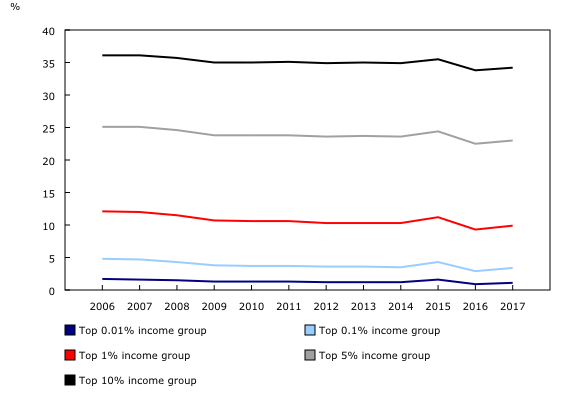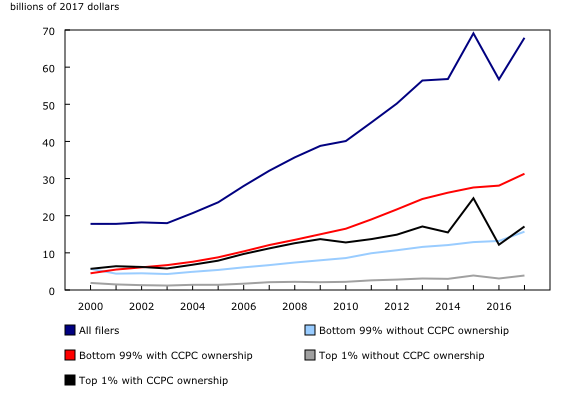Effective tax rates and high income Canadians, 2017
Archived Content
Information identified as archived is provided for reference, research or recordkeeping purposes. It is not subject to the Government of Canada Web Standards and has not been altered or updated since it was archived. Please "contact us" to request a format other than those available.
Released: 2019-09-24
Effective tax rate lower in 2017 than in 2016
Individual Canadian tax filers spent, on average, 11.7% (correction) of their modified total income on federal and provincial/territorial income taxes and employee contributions to Employment Insurance (EI) and the Canada Pension Plan / Quebec Pension Plan in 2017. This was down marginally from 11.8% in 2016 and was the fifth lowest rate in the last 26 years, only 0.4 percentage points higher than the 11.3% effective tax rate in 2009 and 2010.
There was little change in the components of the overall effective tax rate with stable provincial income tax rates combined with a small drop in federal EI contributions (-0.1 percentage points) and a slight increase in federal effective income tax rates (+0.1 percentage points).
Provincial income tax rate drops in Quebec and rises in Newfoundland and Labrador
Effective provincial/territorial income tax rates either increased marginally or were stable in all provinces except for Quebec and Newfoundland and Labrador. In Quebec the provincial effective income tax rate decreased from 5.5% in 2016 to 5.0% (correction) in 2017. This drop was mainly driven by the lowering of the nominal rate for the bottom provincial income tax bracket in Quebec from 16.0% to 15.0%.
In Newfoundland and Labrador, the effective rate rose 0.4 percentage points to 4.5% in 2017, following a 0.3 percentage point increase in 2016. The gains were largely due to progressive increases in provincial nominal income tax rates between 2014 and 2017.
Effective federal income tax rates decrease for families with children with incomes near the median
The effective tax rate for families (12.5%) (correction) is somewhat higher than for individuals (11.7%) (correction) and tends to follow the same year-over-year trends. However, while the federal effective tax rate either increased or was stable across the income distribution, families with children with incomes near the median saw a lower federal effective tax rate as a result of a slight increase in their incomes from the Canada Child Benefit—a tax-free income source.
Top 1% effective tax rate also edges down in 2017
The overall effective tax rate for Canada's top 1% of tax filers edged down from 31.3% in 2016 to 31.0% (correction) in 2017. This was due, in part, to lower provincial effective tax rates for the top 1%.
After the introduction of a fifth top federal tax bracket in 2016, the effective federal income tax rate for Canada's top 1% of tax filers rose from 18.4% in 2015 to 18.8% in 2016, and remained at that level in 2017.
The top 1% of tax filers received 9.9% of total income in 2017, and they paid 21.1% (correction) of the income taxes collected by the federal and provincial/territorial governments. Relative to 2016, their share of income taxes paid rose 1.2 percentage points (correction), while their total income share rose 0.6 percentage points.
Incomes grow faster at the top of the distribution
Average total income of all Canadian tax filers increased by 2.5% to $48,400 in 2017, while the top 1% of tax filers saw their average income rise 8.5% to $477,700.
Growth rates were highest at the very top of the income distribution, with the average total income of the top 0.1% rising by 17.2% and the top 0.01% by 27.2%, the fourth-highest annual increase since 1982.
Income growth was slightly below the average for the bottom half of tax filers in 2017, up 2.4% to $17,200. Growth was lowest for filers in the 51st to 99th percentiles at 1.9%.
To be included among the 277,695 Canadian tax filers in the top 1% in 2017, a tax filer needed a total income of $236,000 or more. To be among the top 0.1 percenters, a tax filer had to earn a total income of at least $740,300, and to be among the 2,780 filers making up the top 0.01% required $2.7 million. An income above $35,100 would place a filer in the top 50%.
Increases in the share of total income limited to the top 1%
Given the different income growth patterns for higher- and lower-income filers, the top 1% were the only group to receive a greater share of total income in 2017. The top 1% of tax filers received 9.9% of total income in 2017, up 0.6 percentage points from 9.3% in 2016. Despite recent fluctuations from 2015 to 2017, this share has been decreasing since 2006.
Income shares were stable at 17.8% for the bottom half of filers in 2017, while they declined 0.6 percentage points to 72.3% for filers in the 51st to 99th percentiles.
Dividends received by Canadian-controlled private corporation owners the most important factor behind the recent trends in top incomes
Income of the top 1% has been relatively volatile in recent years. Average income of these tax filers rose from $486,100 in 2014 to $545,500 in 2015, fell to $440,300 in 2016, and then increased to $477,700 in 2017. Underlying these trends were sharp changes in income received from dividends. Aggregate dividends rose from $57 billion in 2014 to $69 billion in 2015, fell back to $57 billion in 2016, and rose to $68 billion in 2017.
These changes in aggregate dividends were driven mostly by the top 1% of tax filers who owned shares in a Canadian-controlled private corporation, and coincided with the introduction of the fifth federal tax bracket of 33% in 2016. This tax bracket would have applied mostly to tax filers with incomes over $200,000, and they may have taken dividends early to reduce their overall tax burden.
Largest gain in top 1% filers observed in British Columbia
In 2017, the vast majority (92.1%) of the top of 1% tax filers lived in Ontario, Alberta, Quebec and British Columbia, up slightly from 2016 (92.0%) and near the peak of 93.1% in 2006. British Columbia was home to 13.5% of top 1% filers in 2017, up from 12.7% in 2016. This was the highest proportion in the province since 1994. In contrast, Ontario (-0.4 percentage points), Alberta (-0.2 percentage points) and Quebec (-0.2 percentage points) all saw declines in their proportions of top 1% filers.
Representation of women in top income groups continues to increase
Women accounted for almost one-quarter (24.2%) of the top 1% of tax filers in 2017, up from 23.9% in 2016 and more than double the levels of 1982. However, their share of total income received by all top 1% filers was somewhat lower at 21.4%, reflecting the fact that, in the top 1%, women earned on average less ($423,500) than men ($495,000).
Note to readers
Data for 2017 have been added to the Longitudinal Administrative Databank (LAD). This databank now spans 36 years, from 1982 to 2017, and contains information about individuals and their census families.
The LAD consists of a 20% longitudinal sample of Canadian tax filers and provides researchers and analysts with a tool for studying the changes in income of individuals and their families. The LAD contains a wide variety of income and demographic variables and its large sample ensures reliable data for Canada, the provinces, census metropolitan areas and some sub-provincial regions.
Derived from the LAD, data tables for 1982 to 2017 on Canadian tax filers with high incomes, on the low-income dynamics and family income mobility of Canadian tax filers, and on effective tax rates are now available for various provinces and selected census metropolitan areas.
All dollar figures in this release are expressed in 2017 constant dollars unless otherwise noted.
Effective tax and effective transfer rates provide a measure of the size of certain government tax and transfer programs relative to individual incomes. They are calculated by averaging every individual tax filer's ratio of taxes paid to total income. Similarly, effective transfer rates are calculated by averaging the individual ratio of government transfers received to total income.
Effective tax rates respond not only to changes to tax/transfer programs but also to changes in the distribution of income, which in turn reflects both economic and demographic change.
Total income consists of income from earnings, investments, pensions, spousal support payments and other taxable income plus government transfers and refundable tax credits.
Modified total income is used for purposes of calculating effective tax rates and is defined as total income plus capital gains and registered retirement savings plan withdrawals made by persons under 65, less social benefits repayments. Further adjustments to allocate elected split-pension amounts to the spouse claiming the amount were also made.
Federal Income taxes are derived from line 420 of the federal income tax return and exclude the Quebec abatement.
Provincial income taxes are derived from line 428 of the federal income tax return except for Quebec residents, where these taxes are modelled.
Since not all individuals file income tax returns and a small share of tax filers die each year, statistics contained in these tables should be interpreted in the context of living tax filers, not the whole population.
Contact information
For more information, or to enquire about the concepts, methods or data quality of this release, contact us (toll-free 1-800-263-1136; 514-283-8300; STATCAN.infostats-infostats.STATCAN@canada.ca) or Media Relations (613-951-4636; STATCAN.mediahotline-ligneinfomedias.STATCAN@canada.ca).
- Date modified:



